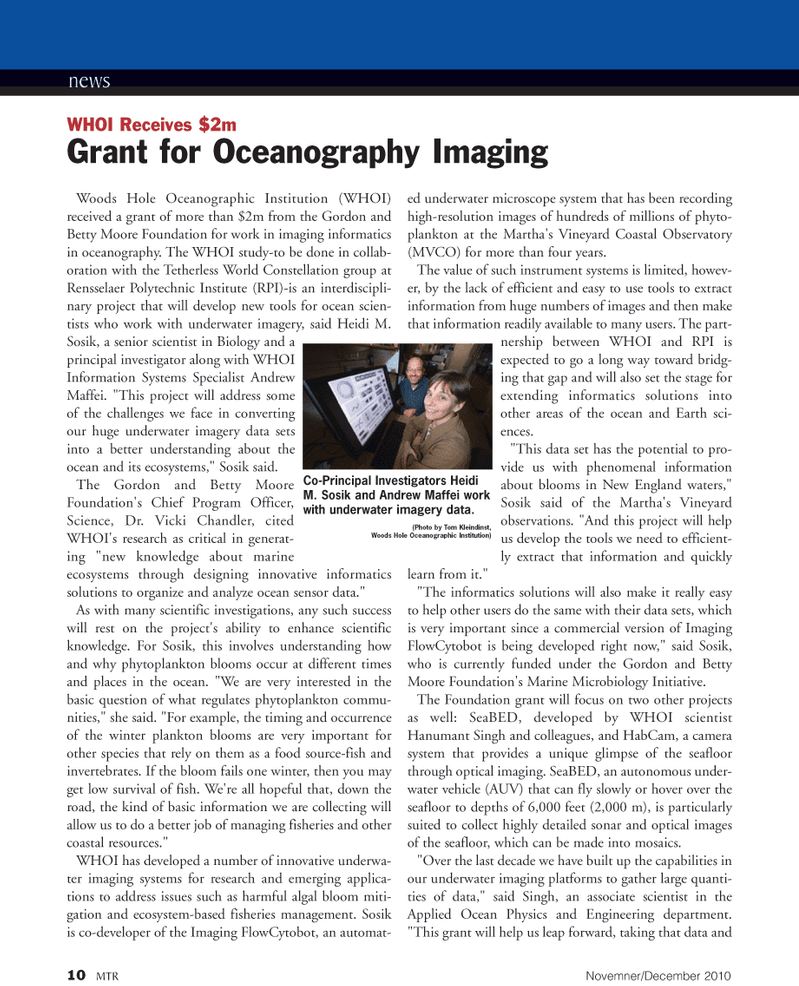
Page 10: of Marine Technology Magazine (November 2010)
Fresh Water Monitoring and Sensors(lakes, rivers, reservoirs)
Read this page in Pdf, Flash or Html5 edition of November 2010 Marine Technology Magazine
news 10 MTR Novemner/December 2010
Woods Hole Oceanographic Institution (WHOI) received a grant of more than $2m from the Gordon and
Betty Moore Foundation for work in imaging informatics in oceanography. The WHOI study-to be done in collab- oration with the Tetherless World Constellation group at
Rensselaer Polytechnic Institute (RPI)-is an interdiscipli- nary project that will develop new tools for ocean scien- tists who work with underwater imagery, said Heidi M.
Sosik, a senior scientist in Biology and a principal investigator along with WHOI
Information Systems Specialist Andrew
Maffei. "This project will address some of the challenges we face in converting our huge underwater imagery data sets into a better understanding about the ocean and its ecosystems," Sosik said.
The Gordon and Betty Moore
Foundation's Chief Program Officer,
Science, Dr. Vicki Chandler, cited
WHOI's research as critical in generat- ing "new knowledge about marine ecosystems through designing innovative informatics solutions to organize and analyze ocean sensor data."
As with many scientific investigations, any such success will rest on the project's ability to enhance scientific knowledge. For Sosik, this involves understanding how and why phytoplankton blooms occur at different times and places in the ocean. "We are very interested in the basic question of what regulates phytoplankton commu- nities," she said. "For example, the timing and occurrence of the winter plankton blooms are very important for other species that rely on them as a food source-fish and invertebrates. If the bloom fails one winter, then you may get low survival of fish. We're all hopeful that, down the road, the kind of basic information we are collecting will allow us to do a better job of managing fisheries and other coastal resources."
WHOI has developed a number of innovative underwa- ter imaging systems for research and emerging applica- tions to address issues such as harmful algal bloom miti- gation and ecosystem-based fisheries management. Sosik is co-developer of the Imaging FlowCytobot, an automat- ed underwater microscope system that has been recording high-resolution images of hundreds of millions of phyto- plankton at the Martha's Vineyard Coastal Observatory (MVCO) for more than four years.
The value of such instrument systems is limited, howev- er, by the lack of efficient and easy to use tools to extract information from huge numbers of images and then make that information readily available to many users. The part- nership between WHOI and RPI is expected to go a long way toward bridg- ing that gap and will also set the stage for extending informatics solutions into other areas of the ocean and Earth sci- ences. "This data set has the potential to pro- vide us with phenomenal information about blooms in New England waters,"
Sosik said of the Martha's Vineyard observations. "And this project will help us develop the tools we need to efficient- ly extract that information and quickly learn from it." "The informatics solutions will also make it really easy to help other users do the same with their data sets, which is very important since a commercial version of Imaging
FlowCytobot is being developed right now," said Sosik, who is currently funded under the Gordon and Betty
Moore Foundation's Marine Microbiology Initiative.
The Foundation grant will focus on two other projects as well: SeaBED, developed by WHOI scientist
Hanumant Singh and colleagues, and HabCam, a camera system that provides a unique glimpse of the seafloor through optical imaging. SeaBED, an autonomous under- water vehicle (AUV) that can fly slowly or hover over the seafloor to depths of 6,000 feet (2,000 m), is particularly suited to collect highly detailed sonar and optical images of the seafloor, which can be made into mosaics. "Over the last decade we have built up the capabilities in our underwater imaging platforms to gather large quanti- ties of data," said Singh, an associate scientist in the
Applied Ocean Physics and Engineering department. "This grant will help us leap forward, taking that data and
WHOI Receives $2m
Grant for Oceanography Imaging
Co-Principal Investigators Heidi
M. Sosik and Andrew Maffei work with underwater imagery data. (Photo by Tom Kleindinst,
Woods Hole Oceanographic Institution)

 9
9

 11
11
